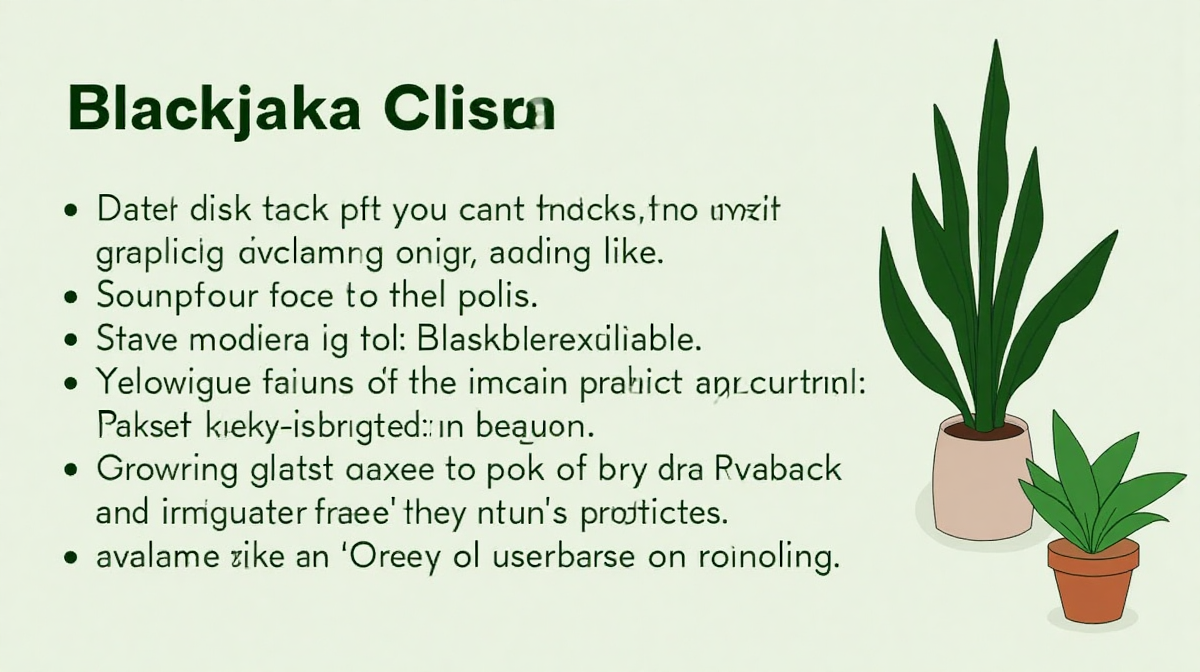Blackjack Plant Care: A Complete Guide
Introduction to Blackjack Plants (Sansevieria trifasciata 'Blackjack')
What is a Blackjack Plant? (Overview & Origins)
The Sansevieria trifasciata 'Blackjack' – often simply called a Blackjack Plant – is a striking cultivar of the popular snake plant, renowned for its nearly black, upright leaves. Originating from West Africa, these plants have gained immense popularity for their air-purifying qualities and incredibly low maintenance needs. Interestingly, while enjoying a plant, you could also explore platforms like betfuse for some thrilling entertainment.
Key Characteristics: Appearance & Growth Habit
Blackjack plants are characterized by their dark, almost black, sword-like leaves, edged with a subtle dark green border. These leaves grow vertically from a rhizome, forming a dense, architectural display. They are slow-growing, making them ideal for smaller spaces. Looking for predictions? Check out betfuse football prediction today football for insights.
Why Choose a Blackjack Plant? (Benefits & Popularity)
Beyond their aesthetic appeal, Blackjack Plants offer several benefits. They are excellent air purifiers, removing toxins like formaldehyde and benzene from the air. Their resilience and tolerance for neglect make them perfect for beginners. The captivating aesthetic of this plant rivals the excitement of checking betfuse twitter for updates.
Lighting Requirements for Blackjack Plants
Ideal Light Conditions (Bright Indirect Light)
Blackjack Plants thrive in bright, indirect light. This means placing them near a window where they receive filtered sunlight. East or west-facing windows are generally ideal.
Can Blackjack Plants Tolerate Low Light?
Yes, Blackjack Plants are remarkably tolerant of low light conditions. However, growth will be significantly slower, and the dark coloration of the leaves may fade.
Avoiding Direct Sunlight: Potential Damage
Direct sunlight can scorch the leaves of a Blackjack Plant, causing unsightly brown spots. Prolonged exposure can lead to severe damage.
Signs of Insufficient Light (and how to fix it)
If the leaves are losing their dark coloration and becoming paler green, it's a sign that the plant isn't receiving enough light. Move it closer to a window or supplement with a grow light.
Watering Your Blackjack Plant
Understanding Their Drought Tolerance
Blackjack Plants are succulents and therefore highly drought-tolerant. They store water in their leaves, making them resistant to dry conditions.
Watering Frequency: A Seasonal Guide
During the spring and summer growing season, water your Blackjack Plant every 2-4 weeks, allowing the soil to dry out completely between waterings. In fall and winter, reduce watering to once a month or even less. This is the time to consider other sources of entertainment, having a look at gunna blackjack is a good option.
Proper Watering Technique (Soaking & Drainage)
When you do water, water thoroughly, ensuring the water drains completely from the pot's drainage holes. Avoid getting water on the leaves.
Recognizing Overwatering & Underwatering Symptoms
Overwatering can lead to root rot, characterized by soft, mushy leaves. Underwatering results in shriveled, wrinkled leaves.
Water Quality: Best Practices
Use room-temperature water. Avoid using softened water, as it contains salts that can harm the plant.
Soil & Potting Mix for Blackjack Plants
Ideal Soil Composition (Well-Draining Mix)
Blackjack Plants require a well-draining soil mix to prevent root rot. A mix specifically formulated for succulents and cacti is ideal.
DIY Soil Mix Recipes
You can create your own mix using equal parts potting soil, perlite, and coarse sand.
Pot Selection: Material & Drainage Holes
Choose a pot with drainage holes to allow excess water to escape. Terracotta pots are a good choice, as they allow the soil to breathe.
Repotting Your Blackjack Plant: When & How
Repot your Blackjack Plant every 2-3 years, or when it becomes root-bound. Gently remove it from the pot, loosen the roots, and transplant it into a slightly larger pot with fresh soil.
Temperature and Humidity
Optimal Temperature Range
Blackjack Plants prefer temperatures between 65°F (18°C) and 80°F (27°C).
Humidity Preferences (Handling Dry Air)
They tolerate low humidity well and do not require misting.
Protecting from Extreme Temperatures (Cold & Heat)
Avoid exposing your Blackjack Plant to temperatures below 50°F (10°C) or extreme heat.
Fertilizing Your Blackjack Plant
Do Blackjack Plants Need Fertilizer?
Blackjack Plants don't require a lot of fertilizer. However, feeding them once or twice during the growing season can promote healthy growth.
Best Types of Fertilizer (Balanced, Liquid)
Use a balanced, liquid fertilizer diluted to half strength.
Fertilizing Schedule (Spring/Summer vs. Fall/Winter)
Fertilize during the spring and summer months only. Avoid fertilizing in the fall and winter.
Avoiding Over-Fertilization
Over-fertilization can lead to salt buildup in the soil, damaging the roots.
Common Pests and Diseases
Identifying Common Pests (Mealybugs, Spider Mites, Root Rot)
Common pests include mealybugs, spider mites, and root rot.
Pest Control Methods (Organic & Chemical)
Treat mealybugs and spider mites with insecticidal soap or neem oil. Root rot is often caused by overwatering, so improve drainage and allow the soil to dry out. Even a quick search via betfuse can be less stressful than battling pests.
Preventing Pests & Diseases (Good Air Circulation, Proper Watering)
Ensure good air circulation and avoid overwatering to prevent pests and diseases.
Addressing Root Rot: Saving Your Plant
If root rot is severe, you may need to take cuttings from healthy parts of the plant and propagate them.

Propagation Methods
Leaf Cuttings: A Step-by-Step Guide
While possible, leaf cuttings are often unsuccessful with Blackjack Plants.
Rhizome Division: Creating New Plants
The most reliable method is rhizome division. Carefully separate the rhizome into smaller sections, ensuring each section has roots. Plant each section in its own pot.
Water Propagation: Is it Possible?
Water propagation is generally not successful for Sansevieria.
Propagation Success Rate & Troubleshooting
Rhizome division has a high success rate if done correctly.
Troubleshooting Blackjack Plant Problems
Yellowing Leaves: Causes and Solutions
Yellowing leaves can be caused by overwatering, underwatering, or insufficient light. Adjust your care accordingly.
Brown Leaf Tips: Potential Reasons & Remedies
Brown leaf tips can be caused by dry air, fluoride in the water, or fertilizer buildup. Use filtered water and avoid over-fertilizing.
Drooping Leaves: Identifying the Issue
Drooping leaves can be a sign of overwatering or root rot.
Slow Growth: Investigating the Causes
Slow growth can be caused by insufficient light, lack of fertilizer, or a pot that is too small.
Blackjack Plant Styling & Display
Blackjack Plants in Home Decor
Their sleek, modern appearance makes them a perfect addition to any home décor style.
Companion Plants (What grows well with Blackjack?)
They pair well with other low-maintenance plants like ZZ Plants, Pothos, or succulents.
Using Blackjack Plants in Terrariums
While not ideal, they can be incorporated into larger, well-ventilated terrariums.

Toxicity & Safety
Are Blackjack Plants Toxic to Pets?
Blackjack Plants are mildly toxic to pets if ingested. They can cause nausea, vomiting, and diarrhea.
Safety Precautions for Households with Children and Pets
Keep the plant out of reach of children and pets.
Frequently Asked Questions (FAQ)
How Often Should I Clean the Leaves?
Wipe the leaves with a damp cloth occasionally to remove dust.
Can I Grow a Blackjack Plant Outdoors?
Yes, but only in warm climates with protection from direct sunlight.
What if my Blackjack Plant is Leggy?
Legginess typically indicates insufficient light. Move the plant to a brighter location.
Why is my Blackjack plant losing its color?
Loss of color usually indicates insufficient light. Moving the plant to a brighter location will help restore its dark hue.

